The final stretch of en primeur releases came yesterday – Tuesday 23rd June (excepting Petrus and Le Pin, which are generally always released at the end of the campaign).
First out of the blocks was the en primeur darling, Les Carmes Haut-Brion. Wine Lister’s CEO, Ella Lister, believes Director, Guillaume Pouthier and his team have produced another stunning effort in 2019, continuing their streak of achieving consistently high scores from critics since the 2014 vintage. She names the wine “heady” and “hypnotising” with aromas of “dark fruit, graphite, and mature roses” on the nose. On the palate she describes the wine as “silky, seductive, and generous”, adding that it is “incredibly pure”.
Aside from Les Carmes Haut-Brion’s clear qualitative success, the additional factors of its small production levels and smart en primeur pricing once again make it one of the most obvious buys of the campaign. One top UK merchant tells me, “we sold out in a matter of seconds”. The bittersweet irony of its huge demand is, of course, that it is reserved only for the lucky few. Indeed, its popularity has soared since the release of the 2016 vintage, which has more than doubled its price since. Its impressive price performance post en primeur release (the 2019 released at £58, 28% below the current price of the 2018) is the cherry on Bordeaux buyers’ favourite cake – Les Carmes Haut-Brion is, perhaps unsurprisingly, the number one Bordeaux wine voted by the trade to have seen the sharpest rise in demand, as shown in the chart below.
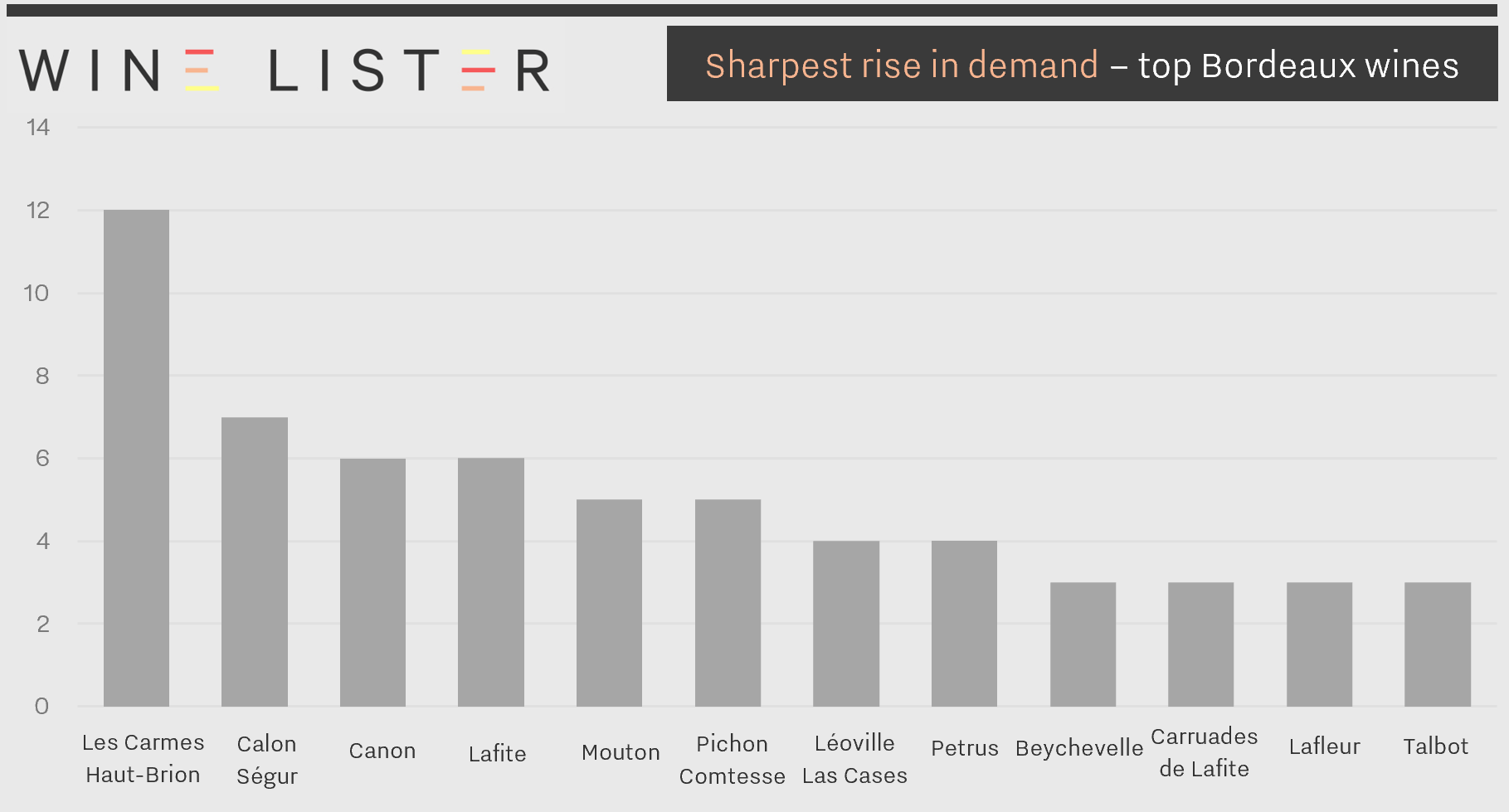 Results from Wine Lister’s 2020 trade survey show Les Carmes Haut-Brion achieves first place for sharpest rise in demand of Bordeaux wines.
Results from Wine Lister’s 2020 trade survey show Les Carmes Haut-Brion achieves first place for sharpest rise in demand of Bordeaux wines.
Joining the fray of hot ticket releases from yesterday was Vieux Château Certan. Wine Lister partner critics were collectively impressed with the 2019, placing its quality on par with the 2018 (which achieves a WL score of 96). Writing for JancisRobinson.com, James Lawther describes the 2019 as a “classic VCC”, while Neal Martin for Vinous hails it a “brilliant follow-up to the 2018”. Releasing at £177 per bottle (in-bond), the latest vintage comes onto the market 20% below the current market price of the 2018.
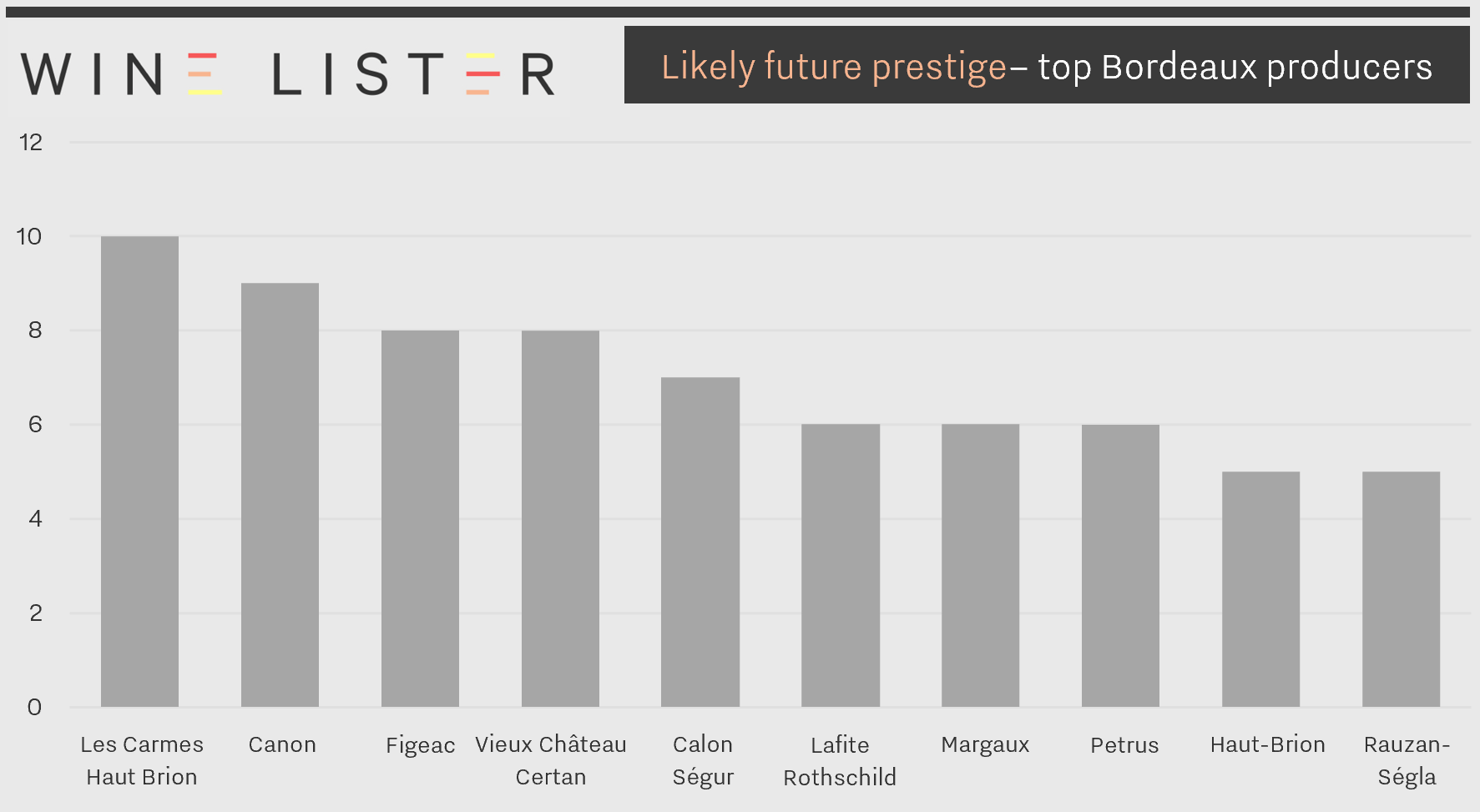 Four releases from Tuesday 23rd June land within the top 10 Bordeaux wines to be voted by key members of the trade as most likely to see future prestige – Les Carmes Haut-Brion, Vieux Château Certan, Canon, and Rauzan-Ségla.
Four releases from Tuesday 23rd June land within the top 10 Bordeaux wines to be voted by key members of the trade as most likely to see future prestige – Les Carmes Haut-Brion, Vieux Château Certan, Canon, and Rauzan-Ségla.
Chanel siblings Canon and Rauzan-Ségla also released their 2019s onto the market yesterday, adding weight to a day full of releases set for bright futures (see image above).
Saint-Émilion star, Canon, released its 2019 to the market at £73 per bottle (in-bond) – 23% below current prices of the 2018 and 2016 vintages. The Canon team characterise 2019 as a “metronome” vintage, referring presumably to the swinging back and forth between climatic extremes. The wet spring and the risk of frost, followed by the strong heat of the summer resulted finally in a perfect finish to the vineyard cycle at the time of harvest, and a wine that sings at perfect pitch. Lister describes Canon 2019 as a “sweet, seductive temptress”, with “voluptuous, racy acidity”, which Director Nicolas Audebert tells us, “2019 is a combination of 2015 and 2016”.
Canon’s Margaux sister, Rauzan-Ségla, also joined the stage, at £57 per bottle (in-bond). A “luscious”, and “lithe” wine, Lister notes the 2019 has “melting fruit, from red to black and back”, and a “toasty, flirty, refined length”. Entering the market 34% below the current price of the 2018 vintage, and offering the second most generous discount on 2018 market prices of the entire campaign (behind only Lafleur), this is sure to see high levels of demand.
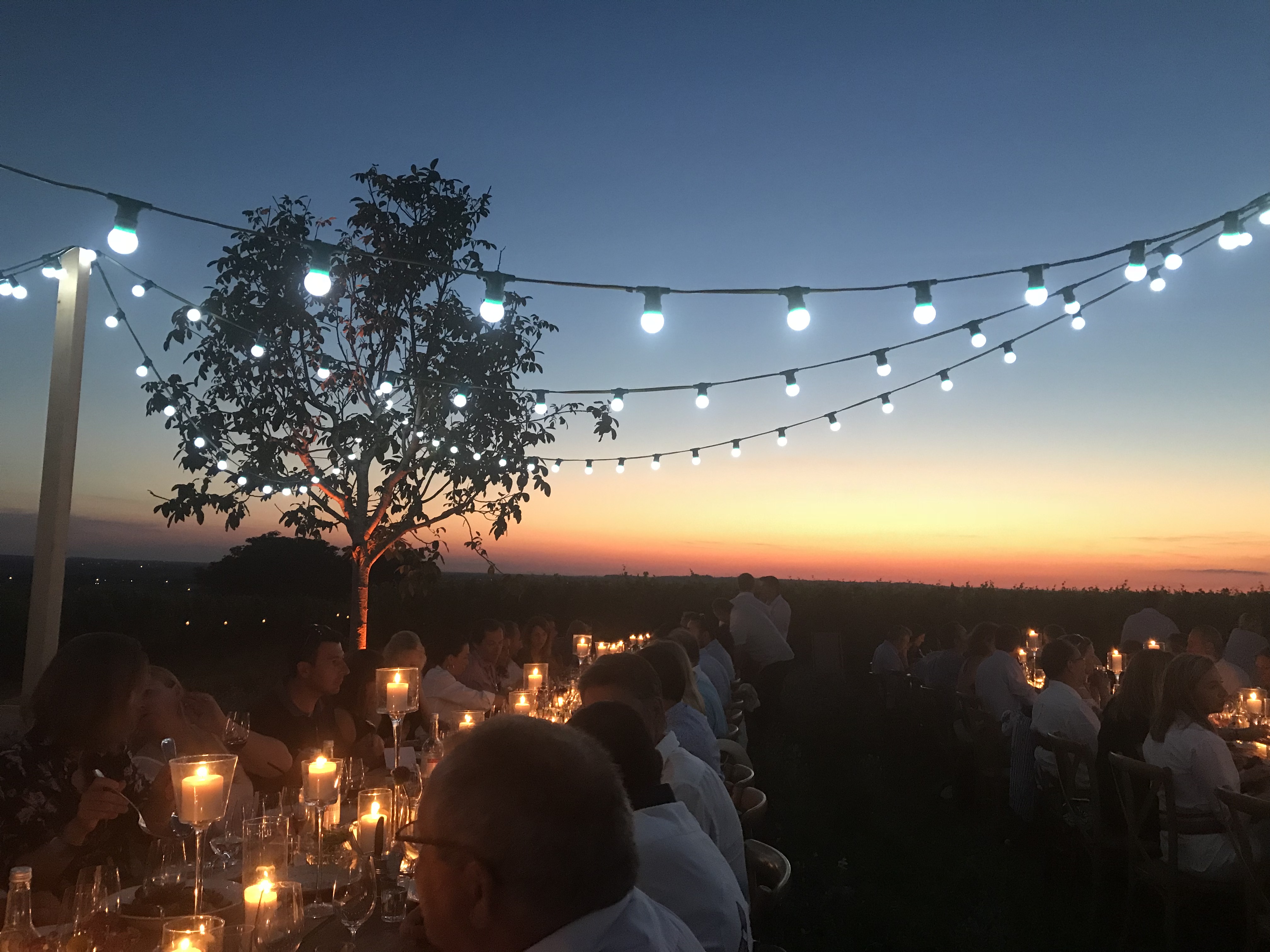 A different time – a throwback to 2018 and a celebration at Château Berliquet, of its acquisition by the Chanel group.
A different time – a throwback to 2018 and a celebration at Château Berliquet, of its acquisition by the Chanel group.
The Chanel group’s new baby, Berliquet, is also growing up fast, releasing its 2019 at £34 per bottle (in-bond). Lister describes “ripe, juicy strawberries” on the nose, adding that it is “very complete, accomplished, and reassuring, with a mineral lift”. On the palate, she finds Berliquet 2019 “rich, full, but very clean-lined”, with “lovely acidity which brings out definition on the finish”. Judging by the immense success of its big siblings, Berliquet has a bright future ahead, and the 2019 is worth snapping up.
Also released yesterday were: Beau-Séjour Bécot and Beauséjour Héritiers Duffau Lagarosse
As we approach the tail end of this busy campaign, the last two working days have seen some promising releases from both banks. Below we examine some of the highlights.
Friday 19th June
Haut-Bailly 2019 was released at £70 per bottle (in-bond), 20% below the 2018 release price. Wine Lister partner critics collectively award the 2019 its highest WL score ever (96), with laudable comments to boot – Antonio Galloni states, “it is easily one of the highlights of the vintage”, while Wine Lister’s CEO, Ella Lister, finds the wine “dark fruited and brooding”, on the nose, and “bewitching, languorous, and layered” on the palate. Haut-Bailly 2019 places second of all Pessac-Léognan reds, after a joint-first WL score of 97 for La Mission Haut-Brion 2019 and Haut-Brion 2019). With a record-high quality, and as a brand on the up, this is a release not to be missed.
Also released on Friday were wines from the Las Cases stable. The flagship wine, Léoville Las Cases, came onto the market at £145.50 per bottle (in-bond) – also a 20% discount from 2018’s opening price. Tasting in Bordeaux two weeks ago, Lister notes the 2019 is “magisterial” with “building power on the finish”. Wine Lister partner critic, Neal Martin, awards Léoville Las Cases 2019 96-98 points, and adds, “there is a clarity to this Grand Vin that places it amongst Jean-Hubert Delon’s finest releases in recent years”.
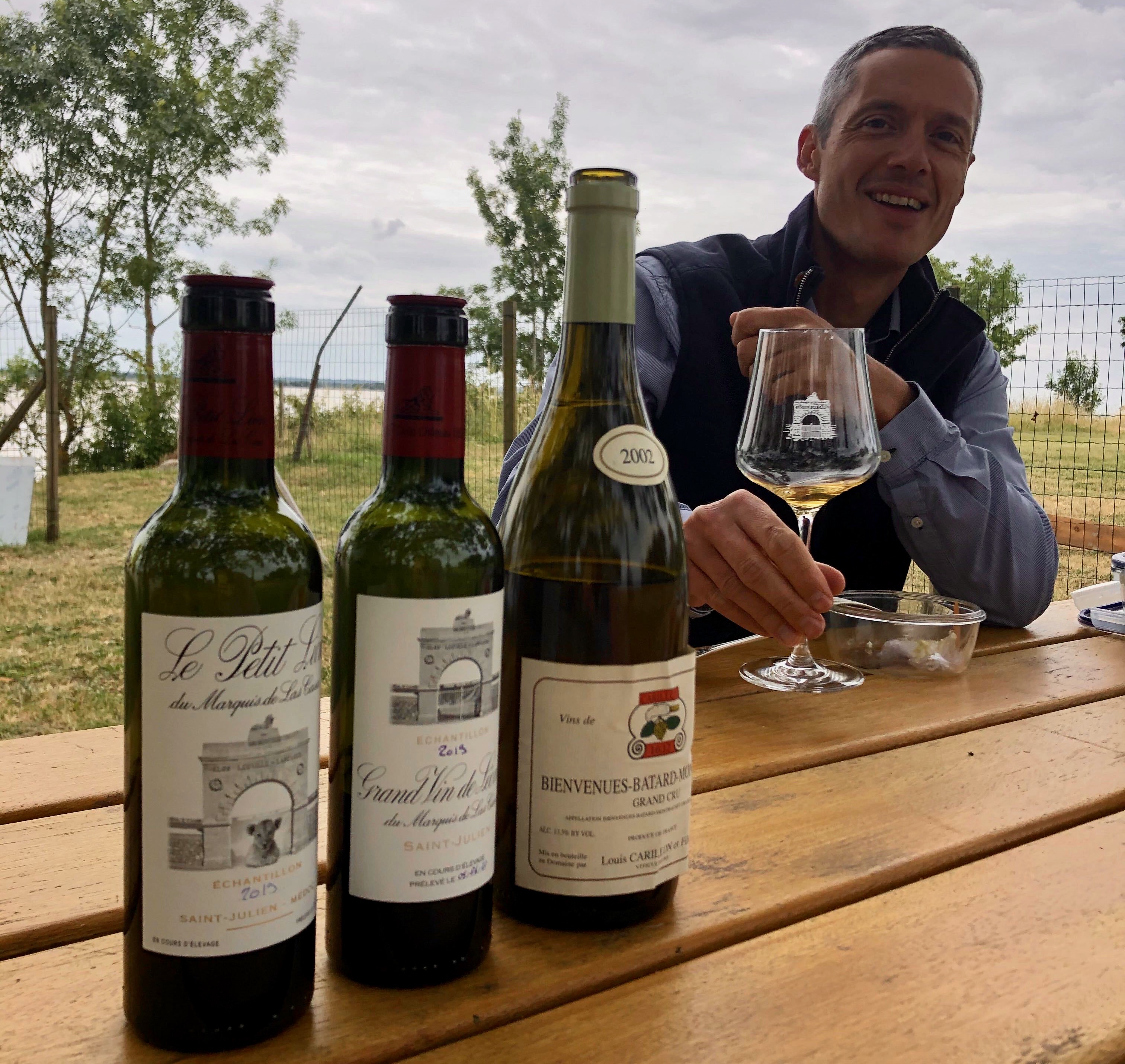 Picnic with Director Pierre Graffeuille – Wine Lister’s CEO, Ella Lister, tasted the Las Cases 2019s in Bordeaux two weeks ago, and describes the Grand Vin as “Luminous, transparent, and lyrical”.
Picnic with Director Pierre Graffeuille – Wine Lister’s CEO, Ella Lister, tasted the Las Cases 2019s in Bordeaux two weeks ago, and describes the Grand Vin as “Luminous, transparent, and lyrical”.
Clos du Marquis and Nénin were also released, each offering good value in the context of similar quality wines produced in their respective appellations – Saint-Julien and Pomerol. Léoville Las Cases’ little brother, Petit Lion, is also exceptionally good value.
Perhaps the most notable release of a very busy Friday was l’Église Clinet 2019. Coming onto the market around the same price as the 2018 at £214 per bottle (in-bond), this is a sure exception to the trade’s “-30%” rule, given its circumstances – the last vintage of owner, the late Denis Durantou, who sadly passed away one month ago. Critics’ scores suggest that this final vintage was his best yet – Neal Martin awards it 97-99 points, and notes, “the perfect way to remember and raise a toast to one of Pomerol’s finest vignerons”. For Thierry Desseauve, l’Église Clinet is one of the wines of the vintage.
Pavie Macquin and Larcis Ducasse also released their 2019s on Friday. The former was one of Lister’s stand-out wines in 2019. She describes it as “bright and self-assured” on the nose, and “juicy and unctuous” on the palate. The latter shows particularly well against the wider Saint-Émilion backdrop. Saint-Émilion Grand Cru Classé “B” Larcis Ducasse 2019 earns a WL score of 95 – one point less than the likes of Cheval Blanc and Pavie, and is priced at just £47 per bottle (in-bond), or an average six times less than its Classés “A” comrades.
Monday 22nd June
Pichon Comtesse made for a powerful kick-off to the Bordeaux 2019 en primeur campaign’s fourth (and possibly final) week. Releasing at £111 per bottle, the latest vintage comes onto the market c.15% below the 2018 and 2016 vintages, if at a c.10% premium to the highly-scored 2015. Wine collectors will nonetheless likely be desperate to get their hands on this, given its resounding praise from critics, not to mention the impressive popularity of the estate. A perennial Wine Lister favourite, CEO, Ella Lister notes the wine has “perfectly poised fruit, interwoven with savoury complexity”. Neal Martin awards Pichon Comtesse 2019 98-100 points, and says, “Whisper it…it reminds me of their First Growth next door neighbour”. Dare we say it – this is Latour-level quality for roughly a quarter of the price.
Also released today is Saint-Émilion superstar, Troplong-Mondot. Its 2019 comes onto the market comfortably below the preceding four vintages on the market, with a price of £63.50 per bottle. Continuing the impressive quality increase and style evolution lead by Aymeric de Gironde and his team, critics are impressed with Troplong-Mondot 2019. Antonio Galloni states, “this is a wine that simply can’t be denied”, and Neal Martin agrees, adding that it is “just a wine you are going to want to drink”.
Further releases from Friday 19th June and Monday 22nd June are: Lascombes, Potensac, Réserve de la Comtesse, Smith Haut Lafitte, and Smith Haut Lafitte Blanc.
Today is the 12th working day since the first major 2019 en primeur release, and over 60 wines are already out.
Among others, the last couple of days have seen the 2019 release of another first growth, a Pauillac powerhouse brand, and a major up-and-comer.
Haut-Brion released its red and white grands vins yesterday, at £295 and £560 per bottle in-bond respectively. While the red enters the market a solid 25% below the current market price of the 2018, the white is the campaign’s most expensive wine yet, and offers a smaller discount, of 5% on 2018.
Following Mouton Rothschild’s lead, Haut-Brion’s red looks well-priced within the current economic context, though buyers may note that the 2014 is available on the market around the same price. The 2012 also looks good – earning a WL score of 96, it is a Wine Lister MUST BUY (and available for c.£260 per bottle in-bond).
Also released from the Clarence Dillon family are Haut-Brion’s baby brother, Le Clarence (at c.£100 per bottle in-bond), and cousins La Mission Haut-Brion red and white. Of the two flagship reds, Haut-Brion is likely the stronger horse to back, based on its first growth status, as well as its position according to the trade among top Bordeaux wines for future prestige (see below).
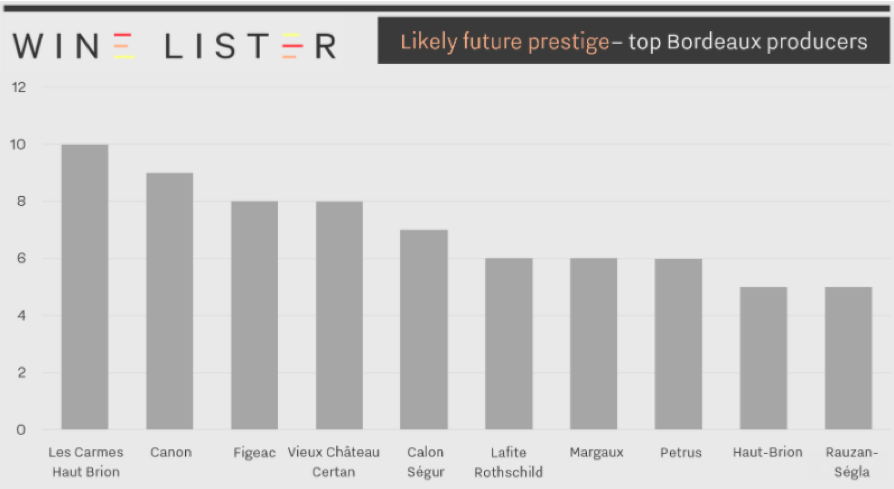 According to Wine Lister’s 2020 trade survey, Haut-Brion is one of top Bordeaux wines most likely to be worth including in collectors’ future cellars.
According to Wine Lister’s 2020 trade survey, Haut-Brion is one of top Bordeaux wines most likely to be worth including in collectors’ future cellars.
Three further pairs of releases from Pessac-Léognan have emerged over the last two days, comprising Malartic-Lagravière, Latour-Martillac, and Carbonnieux.
On Thursday 10th June, Pauillac star-brand Lynch Bages was released, and has resulted in an onward UK selling price of c.£66 per bottle in-bond. Wine Lister’s CEO, Ella Lister, tasted it last week, and found it to be “lifted, precise”, and “a classic”. The price positioning under £70 has reportedly been well-received.
Haut-Batailley was also introduced to the market, at £36 per bottle in-bond. As its second en primeur release under Cazes ownership (the same family as Lynch Bages), the 2019 is 20% under the current market price of the 2018. Following a repositioning of Haut-Batailley’s pricing during en primeur last year, the 2019 release looks good value – the wine’s strong reputation will likely only become stronger with a new wave of investment, and prices are likely to rise accordingly. Lister describes Haut-Batailley 2019 as “pretty”, “elegant”, and “very harmonious”, with a “long, saline, dark chocolate finish” – this is a wine to buy now.
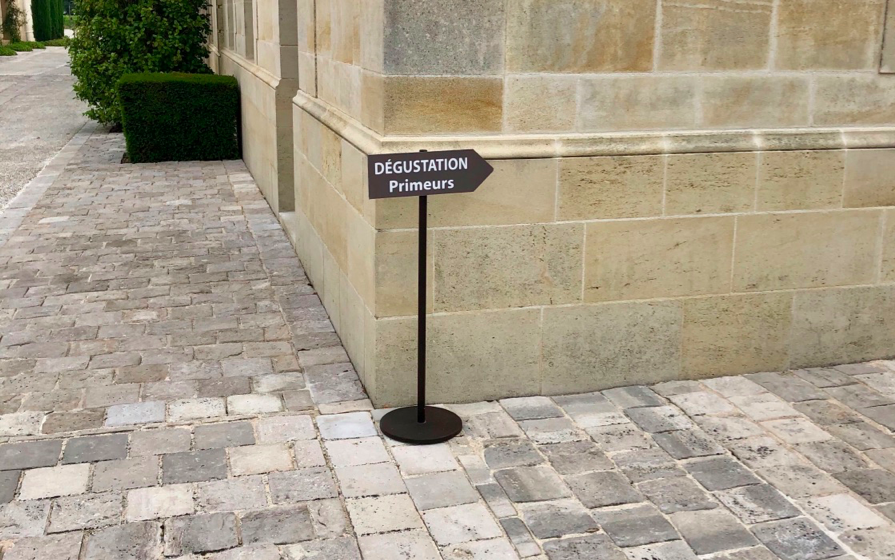 Better late than never – Wine Lister’s CEO, Ella Lister, has now tasted the majority of Bordeaux 2019s. Watch this space for her favourites, and Bordeaux 2019 MUST BUYs coming soon.
Better late than never – Wine Lister’s CEO, Ella Lister, has now tasted the majority of Bordeaux 2019s. Watch this space for her favourites, and Bordeaux 2019 MUST BUYs coming soon.
One further release for each side of the river caught Wine Lister’s eye this week: La Gaffelière 2019 was released 13% beneath the current 2018 market price. The château’s director, Thomas Soubes, told Wine Lister that he was very happy with the quality of their 2019, and Lister concurs – she finds the wine “serious” and “charming”, with “velvet tannin” and “seductive red fruit”. La Gaffelière continues to present excellent value for its impressive quality, relative to wines sharing the Saint-Emilion Grand Cru Classé “B” classification.
Calon Ségur 2019 was also released yesterday. As one of the top rising stars of Bordeaux, its 2019 came onto the market 10% below the 2018 release price, but crucially 31% below 2018’s current market price. Calon Ségur is one of the “poster children” for the true benefits of buying en primeur. Lister found Calon Ségur 2019 to be “perfumed”, “juicy”, and “unctuous”, with “spice on the mid-palate” and a “saline, super-precise finish”. As ever, this is worth snapping up before its price inevitably increases post en primeur release.
Also released during the same period were: Cantenac-Brown, Capbern, Clos Fourtet, Clos René, Cos Labory, Kirwan, Monbousquet, Moulin Saint-Georges, Pavie, Phélan Ségur, Pibran, and Suduiraut.
Keep up to date with further Bordeaux 2019 en primeur releases through Wine Lister’s dedicated en primeur page.
Wine Lister is a big fan of Bordeaux – the city, the people, the wines (of course), and we even have a soft spot for its idiosyncratic system for selling wines. This year has thrown us, as we learn about the 2019 vintage from our desks, confined to our homes, rather than out on the “Médoc highway” or between the walled roads of the right bank.
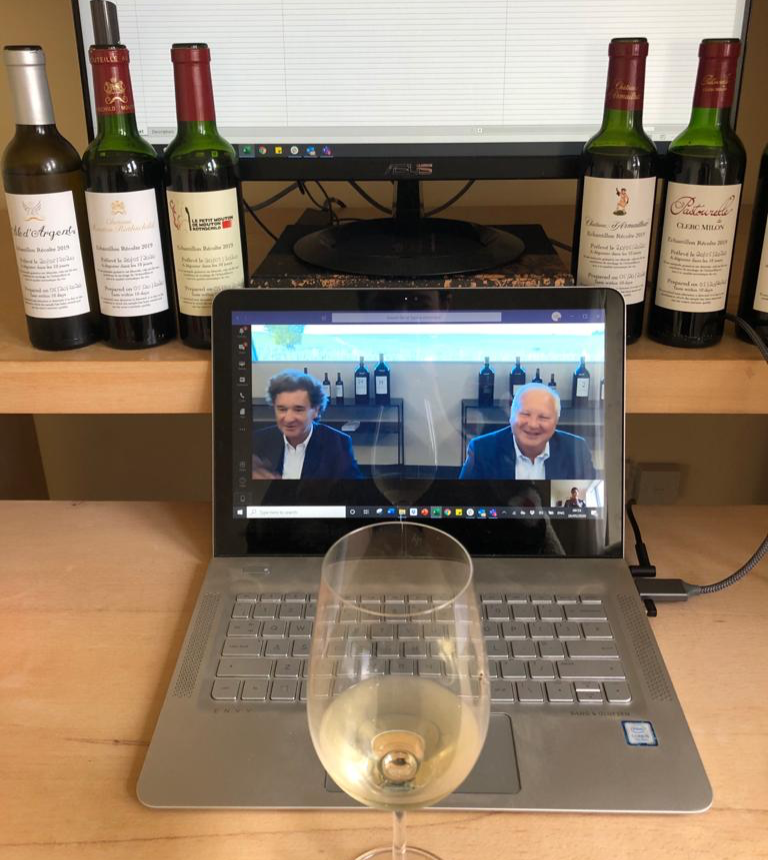 Virtual tasting – Wine Lister’s Founder & CEO, Ella Lister, tastes the Baron Philippe de Rothschild 2019s with Philippe Sereys de Rothschild and Managing Director, Philippe Dhalluin.
Virtual tasting – Wine Lister’s Founder & CEO, Ella Lister, tastes the Baron Philippe de Rothschild 2019s with Philippe Sereys de Rothschild and Managing Director, Philippe Dhalluin.
From what we have heard and read (and from the little we have tasted so far), the 2019 vintage in quality terms is in line with recent greats – 2018, 2015, 2010, and 2009. The current global pandemic makes for an unlucky welcome party for a wine that had luck on its side all through the growing season. Climatic events for the 2019 vintage were far less extreme than for 2018 or 2017. Frost threatened, and heat waves came, but each time the majority of vineyards escaped from disaster. “There was heat, but rain each time we needed it at the precise right moment”, explains Cos d’Estournel’s owner Michel Reybier. He names his Grand Vin in 2019 “miraculous”, and adds that Cos d’Estournel Blanc is the “best white they’ve ever made”. Miracles occurred further south in the Médoc, too – Technical Director Nicolas Glumineau believes that Pichon Comtesse 2019 has finally overtaken the heights of his heretofore “hero wine”, Montrose 2010.
Many producers we have spoken to echo this sentiment, underlining the high quality of the wines made in 2019, and notably, their impressive balance. The best examples in 2019 have reportedly achieved the vinous holy grail: equilibrium between the triumvirate of flavour concentration, structure (from tannin and alcohol), and acidity, thanks in part to the “balanced” weather conditions throughout the growing season.
The winter of 2018-2019 was unusually mild, causing budbreak to occur between five days and two weeks early. While such a phenomenon might normally cause the rest of the season to be premature, including harvest, the vinous clock soon righted itself thanks to a cool spring. Bordeaux spent several nights on frost-alert from late March to mid-May. Véronique Sanders, Director of Haut Bailly tells us they lit fires in the vineyards to protect from frost on at least five occasions during the spring of 2019 – on 27th and 28th March, 13th April, and 5th and 6th May. With no frost damage, and flowering back to “normal” timing, the next challenge facing the 2019 vintage was heat. France’s south-west experienced another hot summer in 2019, but rain arrived just in time on three occasions: one in July, once in August, and then some light showers in early-mid September, bringing freshness and energy to the grapes before harvesting.
Hot and dry spells through the summer have made 2019 a Cabernet Sauvignon vintage; the grape takes up a slightly higher proportion than normal of the blend of many Grands Vins. By the same token, the cooler spells have resulted in good freshness for Merlot. Philippe Dhalluin, Managing Director at Baron Philippe de Rothschild, says that Merlot across the group’s châteaux is the best since 2010, but that the Cabernet Sauvignon is so good, that the high quality of the former will be of benefit largely to the second wines. Mouton Rothschild is made up of 90% Cabernet Sauvignon in 2019, a higher proportion than average.
2019 was lucky in volume, as well as in quality. Dhalluin tells us production volumes of the Baron Philippe stable are normal-to-generous, and he is not alone. On the right bank, Director of La Gaffelière, Thomas Soubes, says “we are lucky to have quality and quantity this year”. Where in 2018 properties across both banks were forced to triage vigorously because of mildew, and started with lower yields due to severe heat stress on the vines, 2019 evaded both of these afflictions. Also contributing to good volumes at many properties were exceedingly healthy grapes at the time of harvest. Director of Talbot, Jean-Michel Laporte explains, “thanks to the impressive health of the grapes, sorting in 2019 was purely about choosing the very best quality”. The first Merlot grapes harvested at Pichon Baron certainly seemed a hopeful sign for the liquid to come.
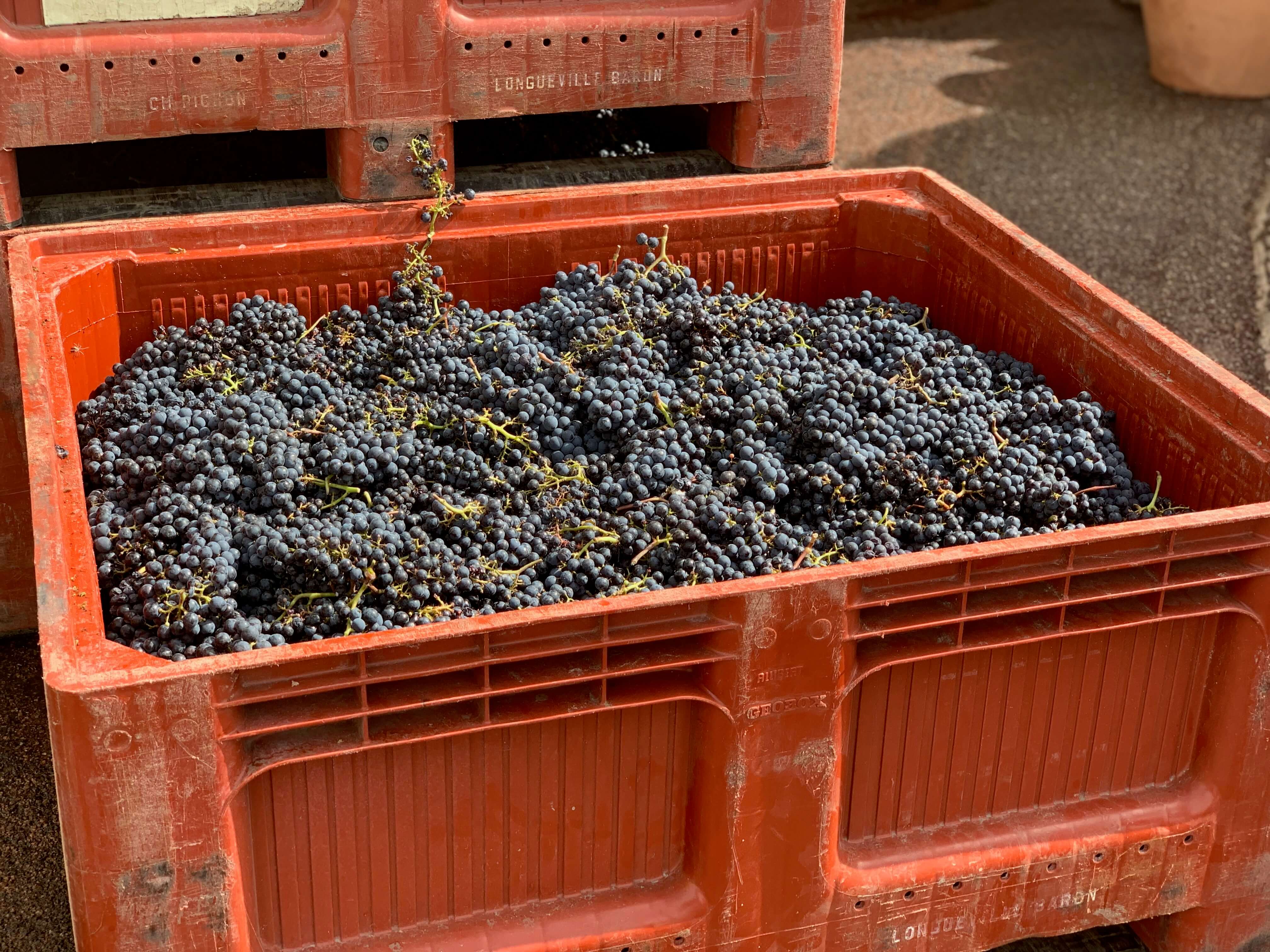 23rd September 2019 – some of the first Merlot grapes to be harvested at Pichon Baron.
23rd September 2019 – some of the first Merlot grapes to be harvested at Pichon Baron.
Though the Wine Lister team is yet to taste the majority of Bordeaux 2019s, their quality appears to be a good news story for a world on lockdown. While the current market could be considered a rather ill-fitting stage for a vintage with such qualitative promise, the releases have just begun (with Pontet-Canet the first major release). Early signs are that the Bordelais are listening, and might just reduce prices in line with the global crisis. For anyone with the headspace for en primeur in the current context, this is a campaign not to be missed.
Wine Lister looks forward to tasting more of the wines as soon as it becomes possible. In the meantime, we will be providing the usual campaign coverage, in the form of real-time release emails for Wine Lister Pro Subscribers, and Twitter alerts for all our followers, as well as live updates on our dedicated en primeur page.
A second post on Bordeaux 2019 will focus on the campaign, and discuss pricing within the unprecedented context of this year’s releases. Watch this space.
Last week’s blog post examined two of the most popular Wine Lister website features amongst collectors: the MUST BUY recommendation tool and the Compare Tool. Wine Lister’s Vintage Value Identifier helps the modern wine collector to further refine their online investigations.
Featured on each wine page, the dynamic Vintage Value Identifier gives a clear visual of quality-to-price ratios across the vintages of a given wine, and applies a Value Pick Score to measure the relative value.
By performing the price analysis for you, this tool pinpoints exact vintages of your favourite wines that are the best options to buy or sell, based on the impressive quality for their price.
See the example of Montrose below, or by exploring its wine page here.
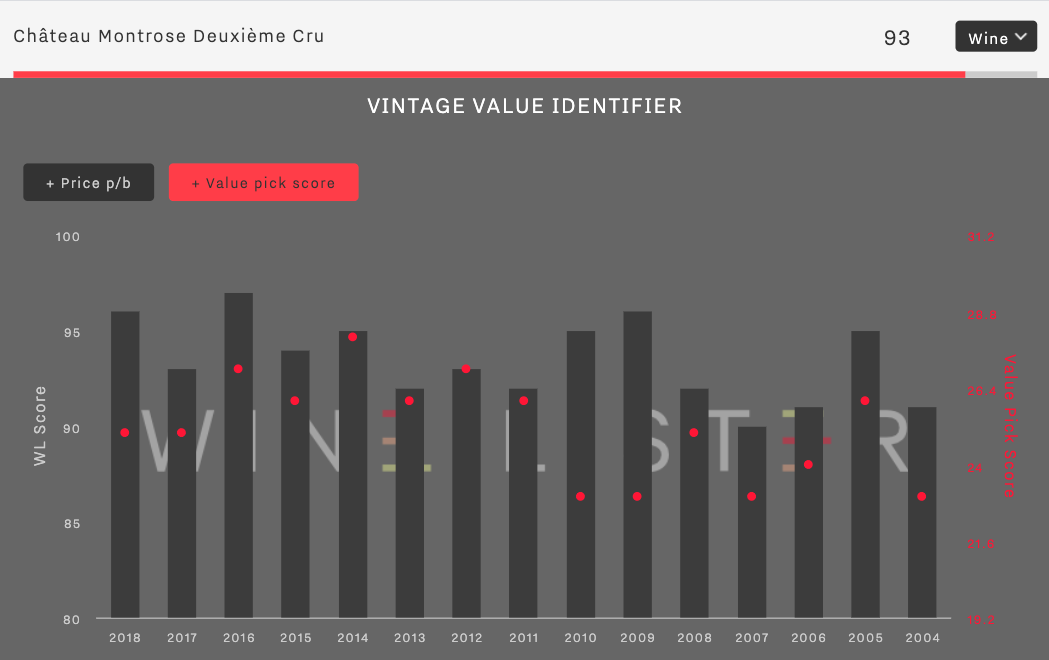
As indicated by the red dots, and values on the right-hand axis, Montrose’s Value Pick Score fluctuates between vintages. The 2004, 2007, 2009 and 2010 vintages share the lowest Value Pick Score (23), while the 2014 Montrose achieves the highest score of 28.
The 2014 vintage tends to represent excellent value across the board in Bordeaux. This is due to its good (if not excellent) quality overall, and its release after the lesser-quality 2013 (which kept release prices down). Montrose’s 2014 was awarded 96 points by Wine Lister partner critic, Neal Martin, who notes, “a bouquet that exudes class and sophistication: pure and mineral-driven black fruit, cedar and pencil lead, hints of blueberry developing with aeration although it never impedes upon the sense of terroir”.
While the true benefit of the Vintage Value Identifier lies in the Value Pick Score, it is still possible to view the pure price vs. quality analysis, as illustrated below:
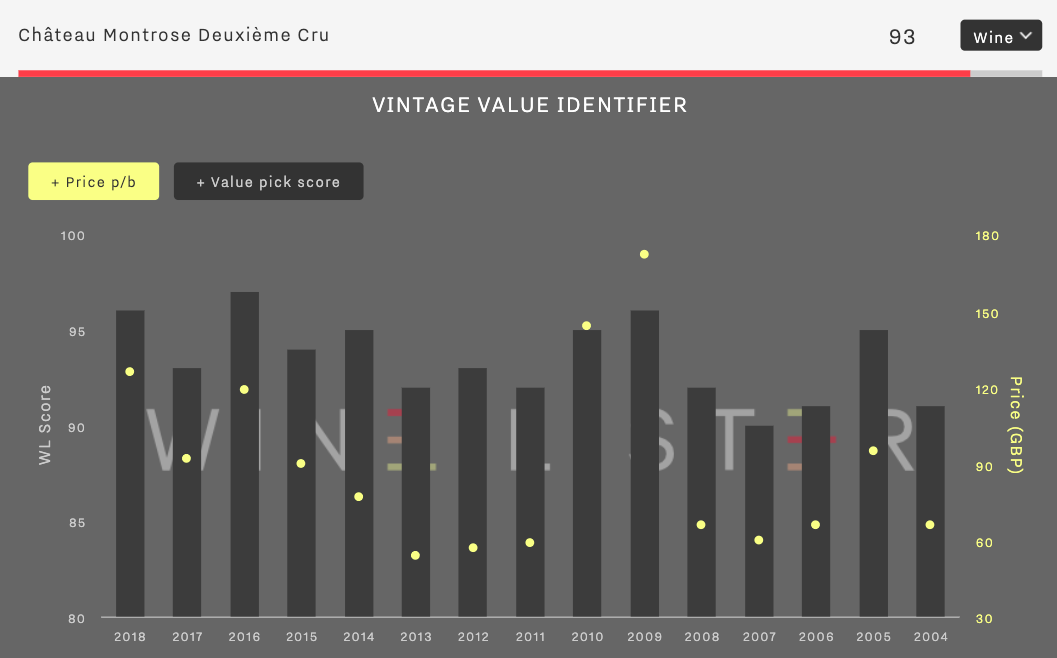
While Montrose 2009 achieves the second-highest WL Score of the featured vintages, it also commands the highest price (£172 per bottle in-bond, when buying by the case). Achieving MUST BUY status, the 2014 vintage is conversely priced at £77 per bottle in-bond for a similar level of quality (hence the higher Value Pick Score). The 2014 Montrose is available to purchase from Corney & Barrow, Cult Wines, Justerini & Brooks, and BI Fine Wines (the latter in magnums only).
Guiding your future purchases, you can identify good value in back vintages of any wines by using the Vintage Value Identifier on each wine’s page. Click here to start your own analysis.
Wine Lister is currently offering a range of portfolio analysis services to private clients. If you are interested in having your wine collection analysed by our team of fine wine data experts, please don’t hesitate to contact us.
As we spare a thought for Bordeaux during what would have been the 2019 en primeur tasting week, we continue to encourage our readers to investigate the abundance of physical vintages available from this noble region. This week we examine the top Bordeaux MUST BUYs in four of the five left bank classified growth groups.
Though the tasting and sale of 2019 may be postponed, 17 reds from last year’s en primeur campaign (2018) still appear in our top MUST BUYs selection, and are worth snapping up for future drinking. The impressive quality of recent physical vintages in Bordeaux, namely 2016 and 2015, is clear to see – each vintage earns 10 and nine MUST BUY places respectively in the Wine Leagues below.
Of the 222 Bordeaux wines that are currently identified as MUST BUYs, 97 are Médoc classified growths. Looking at the top 10 wines for ‘Cru Classé’ levels (second to fifth), WL scores indicate that the quality structure intended in the 1855 classification is perhaps not so rigid, now that modern winemaking techniques have more of an influence. For example, five wines in both the third and fourth growth groups earn 94 WL, and six wines among top fifth growths earn the same score.
These rankings are formulated by Wine Lister’s new interactive tool – Wine Leagues – which can be accessed here.
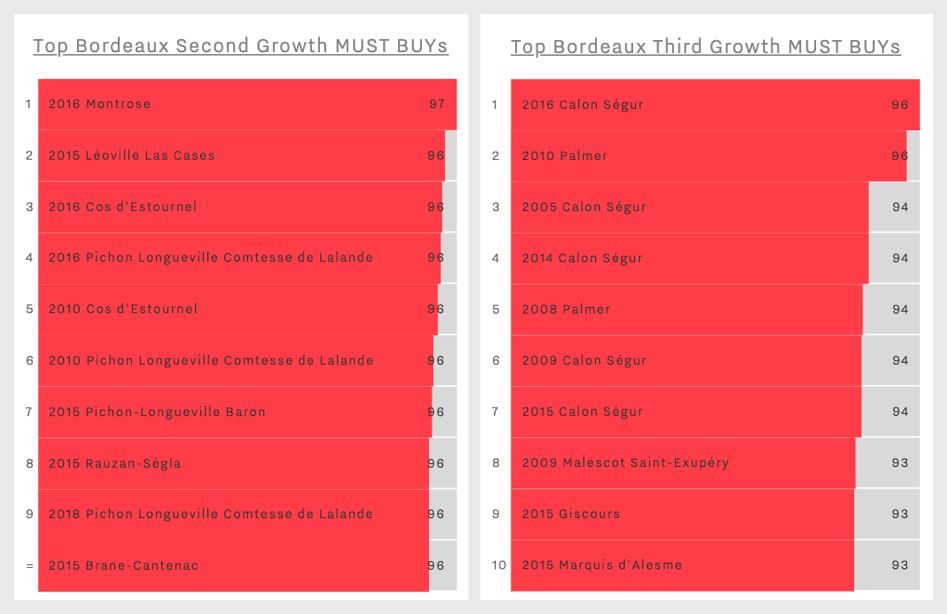
With a WL Score of 97, Montrose’s 2016 release takes the lead spot in the list of top Bordeaux second growth MUST BUYs. Awarded 98 points by Wine Lister partner critic, Antonio Galloni, and described as ‘a wine of pedigree, depth and character’, this wine comes at price of £111 (per bottle, in-bond, when buying by the case). Super-second Pichon Comtesse features three times – with 2016, 2010 and 2018 vintages present. The latter two vintages are available in-bond at Goedhuis & Co – the 2010 would make for a great lockdown indulgence, whilst the 2018 is an investment for future drinking.
Calon Ségur dominates the Bordeaux third growth wine league, occupying half of the top 10 spots with vintages 2005, 2009, 2014, 2015 and 2016. The average cost of these vintages is £71 (per bottle, in-bond). Palmer features twice, though at a higher price – its two listed vintages (2008 and 2010) are available at £204 and £155 respectively from BI Fine Wine & Spirits.
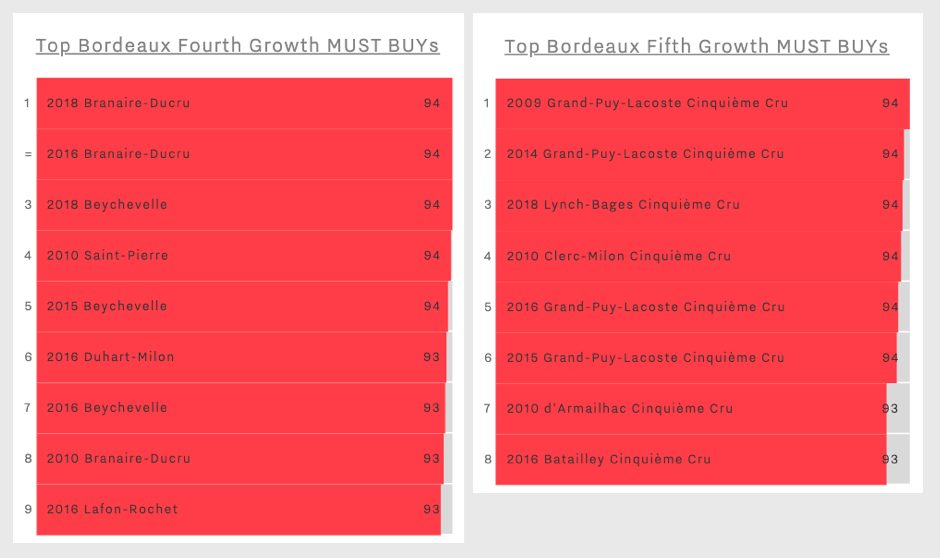
The top Bordeaux fourth growth MUST BUY list is dominated by more recent vintages (2015-2018). Occupying the top two positions with its 2018 and 2016 releases, Branaire-Ducru has a notably good quality-to-price ratio. Both vintages achieve a WL Score of 94 at the cost of £38 per bottle (in-bond). The 2018 Branaire-Ducru achieved special mention in last year’s examination of WL MUST BUYs from Bordeaux en primeur 2018, as did Beychevelle. Both wines are available to purchase by the case (in-bond) at Albany Vintners.
Of the 18 Bordeaux fifth growths, eight achieve MUST BUY status. Grand-Puy-Lacoste achieves multiple entries on the League, with 2009, 2014, 2015 and 2016 all receiving a WL Score of 94. These four deliverable vintages are available from several UK merchants including Berry Bros & Rudd, where prices start from £245 for the 2014 vintage (per case of six in-bond). Described by Neal Martin as ‘one of the great vintages from this estate in the modern era’ the cost of the 2009 supersedes its descendants – a case of six bottles starts at £450 (in bond).
All users can see the standard Wine League page here. Pro users have access to a more extensive set of Leagues, and can log in to access here.
While we would normally be packing our bags in preparation for one of Wine Lister’s favourite weeks of the year, the postponement of this year’s Bordeaux en primeur tasting week comes as a blow for all. Until we can sample the eagerly-awaited 2019 vintage, we can comfort ourselves in self-isolation with the abundance of physical Bordeaux vintages still available for delivery.
In celebration of the brilliant wines that are helping keep Wine Lister’s glasses half-full during the pandemic, this week we focus on some of the best red Bordeaux Value Picks, so that you too can avoid compromising on your quarantine drinking preferences without breaking the bank.
Wine Lister’s Value Pick score is calculated based on the quality-to-price ratio of a wine and vintage, as informed by price data and reviews from our partner critics. See the image below for five of our top Bordeaux Value Picks over the past four vintages.
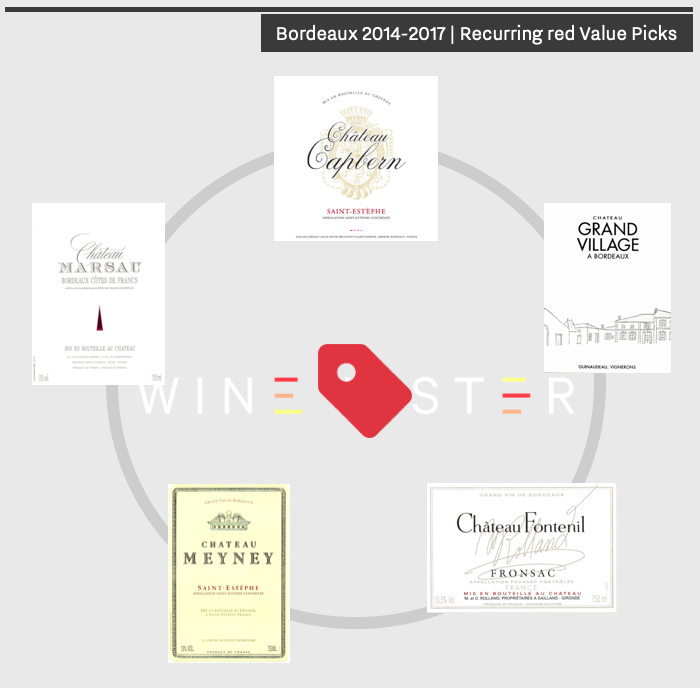
- Château Capbern
Capbern obtains an average Value Pick score of 35 across the last four deliverable Bordeaux vintages, and offers excellent value for money. This Saint-Estèphe château is the sister property of Calon-Ségur. Described by one of our partner critics, Jancis Robinson, as a ‘veritable steal’, the 2014 vintage ‘continues to look exceptionally good and still fully deserving of its score of 17 en primeur’. The 2016 vintage achieves Capbern’s highest WL Value Pick score (36.2) of the four vintages, and we highly recommend getting your hands on some, available by the dozen in-bond starting from £200, from UK merchants including Farr Vintners and FINE+RARE. Millésima USA and Millésima HK also deliver this brilliant wine.
- Château Grand Village
Achieving Value Pick status for three of the four vintages examined (2017, 2016, 2015), Grand Village exhibits a dependably high quality-to-price ratio. As the original Bordeaux home of the Guinaudeau family – the producers of Lafleur – Grand Village is the accessible answer to the same exceptionally high winemaking standards applied to its parent wine. Its classification as a Bordeaux Supérieur plays a part in its inherently reasonable price (c.£13 per bottle in-bond, when buying by the case). Grand Village’s 2017 vintage achieves the highest Value Pick score (38) of all five wines and four vintages here mentioned, and is available for delivery from the Guinaudeau family wines’ UK agent, Justerini & Brooks.
- Château Fontenil
A second Value Pick from an ‘outlying’ Bordeaux appellation, Fontenil’s 8.5-ha vineyard is located at the highest elevation on the plateau of Fronsac. As renowned flying winemaker, Michel Rolland’s ‘passion project’, he purchased the site with his wife, Dany, in 1986 with the intention of inhabiting the house that was situated on its land. Taking on the responsibility of attending to the vines that came with it, and creating an entirely new estate, Fontenil is now a boutique wine of excellent quality at an average cost of c.£20 per bottle in-bond. Given its small production volume, Fontenil is not as easy to find as our other four Value Picks, however, in the UK, Laithwaites is the place to buy (as soon as they reopen their website for orders – they are currently experiencing an overload of demand due to lockdown buying).
- Château Meyney
Located in the east of Saint-Estèphe, the plots of this Cru Bourgeois are situated next to Montrose. Long considered a wine trade darling for its impressive value, Meyney continues to achieve high WL scores. Its 2015 vintage received particular praise from our partner critics, with Neal Martin describing it as ‘blowing everyone’s expectations, including his own‘. With prices starting at £25 per bottle in-bond, you can order this wine through Goedhuis in the UK, where a case of 6 bottles stands at £200, including VAT. If you are in the USA, you can place your order with Millésima.
- Château Marsau
Like Meyney, Marsau’s 2014 and 2015 vintages are Wine Lister Value Picks. The 2016 is too, and though the wine seems to get better every year, the latter may need a touch more time in bottle before drinking. Marsau is run by Anne-Laurence and Mathieu Chadronnier (Managing Director of the Bordeaux négociant, CVBG). The Marsau vineyards feature 85% Merlot planted on predominantly clay soils, resulting in a classically right-bank wine with soft, round fruit and great balance. The 2014 vintage represents particularly good value – priced at £20 for the bottle in-bond, with a high Value Pick score of 35. The UK-based merchant BI Wines is delivering this vintage, whilst those on the other side of the pond can place their order with JJ Buckley Fine Wines.
You can identify good value in further back vintages of any of the above-mentioned wines by using the Vintage Value Identifier on each wine page. See the example for Meyney below or by clicking through to its wine page here.
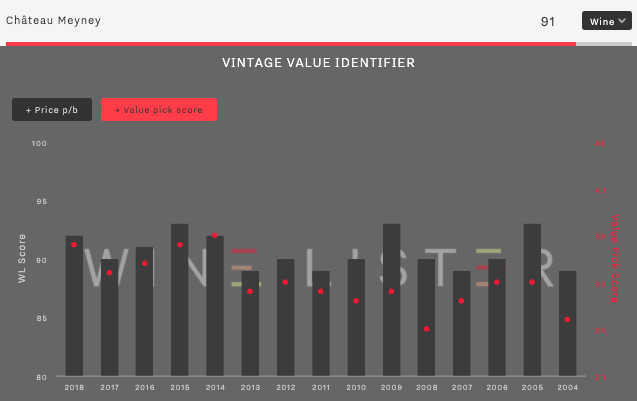
While the world continues to tackle the outbreak of Covid-19, we at Wine Lister are trying to continue with “business as usual” – at least as far as is possible, while also thinking of all our friends in wine regions and markets that are struggling in this uniquely difficult time. This of course includes California – that idyll for sunshine and free love as featured in many a hit song and many a hit wine list.
Of all fine wines from the New World, offerings from California have succeeded in grabbing the attention of fine wine collectors, with some even reaching “cult” status. With this in mind, we are California dreaming this week, and examine below the wines from California’s foremost regions – Napa and Sonoma Counties.
Both production areas offer an abundance of top-quality wines, though at a price. The high prices of several Napa County AVAs, including Oakville and the Napa Valley, mean that its wines can appear expensive when compared to its sibling, Sonoma County.
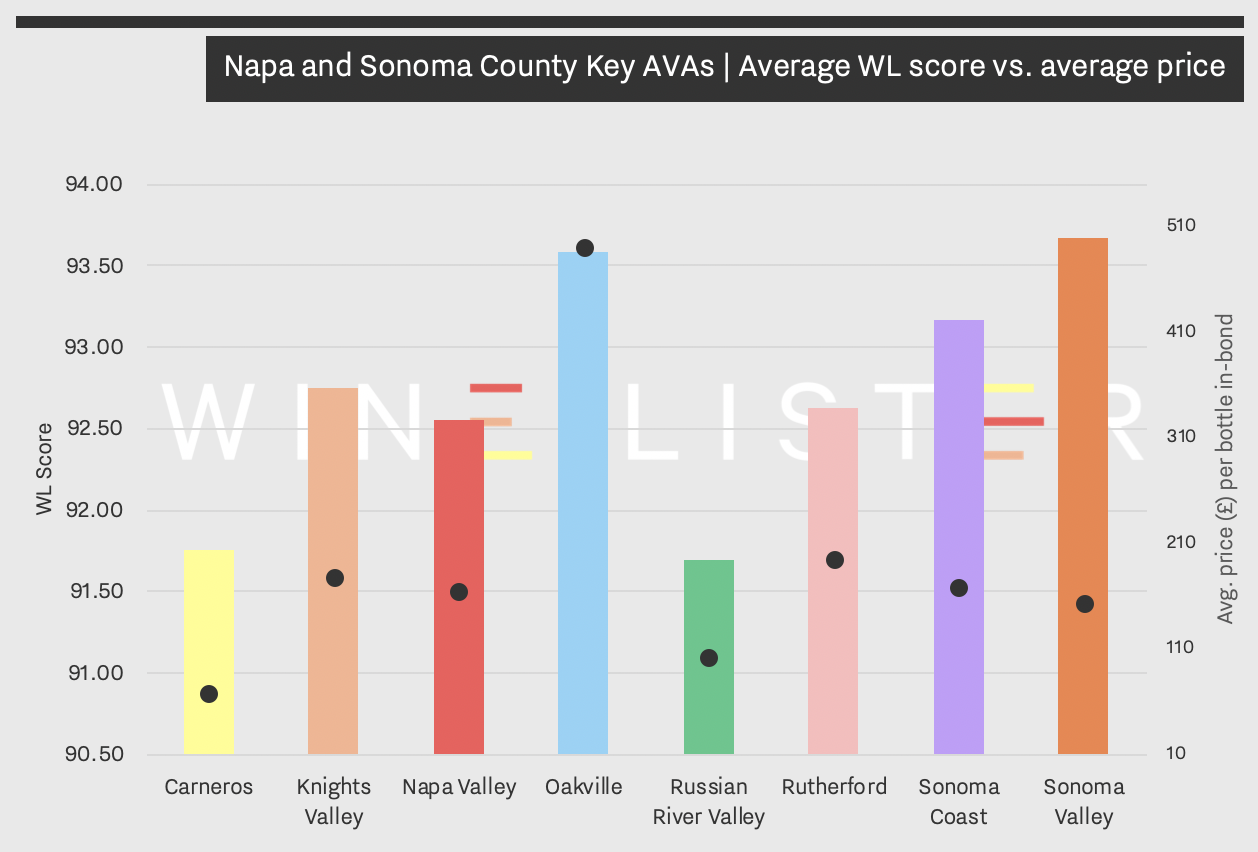
The chart above shows the average WL Score and price (£) per bottle in-bond (when buying by the case) of the top eight AVAs in Napa and Sonoma Counties.
Two AVAs consisting only of white wines stand in stark contrast. Carneros is represented by four Chardonnays – Kistler Vineyards’ Hudson Vineyard, Ramey Wine Cellars’ Hudson Vineyard, Shafer Vineyards’ Red Shoulder Ranch, and Cakebread’s Chardonnay Reserve, earning an average WL score of 91.8. Accompanying its relatively low WL score is the second-lowest average price of all AVAs – c.£67 per bottle in-bond. This remains excellent value in the wider fine wine context, given that Chardonnay with similar scores from Burgundy can fetch up to c.£1,000 (for example, Coche-Dury’s Meursault Les Caillerets).
At the other end of the quality scale is Sonoma Valley AVA, represented by three Chardonnays from Kistler Vineyards. Its average WL score of 93.7 is the highest amongst its Californian peers. Considered a cult Californian winemaker, the Kistler Winery emulates the Burgundian “terroiriste” approach, committing wholeheartedly to wines that best reflect each individual plot.
The Napa County groups command a higher price tag on average than their Sonoma counterparts. Oakville’s selection of predominantly red wines holds the second-highest WL score, however its average price is over double that of the second most expensive region – Rutherford. This is explained by the presence of Screaming Eagle Cabernet Sauvignon, which, at an average price of £2,863 per bottle, drives the region’s quality-to-price ratio down. The mailing list model of Jean Philips’ low-production Napa Valley winery has amassed an incredible cult following of fine wine buyers, who seemingly seek access to the wine at any cost.
While Sonoma County may appear to offer the better value (with red wines such as Kenwood Vineyards Artist Series Cabernet Sauvignon, or Hirsch Vineyards Block 8 Estate Pinot Noir, to add examples to Kistler’s whites), Wine Lister’s top 10 Californian MUST BUYs are all from Napa County.
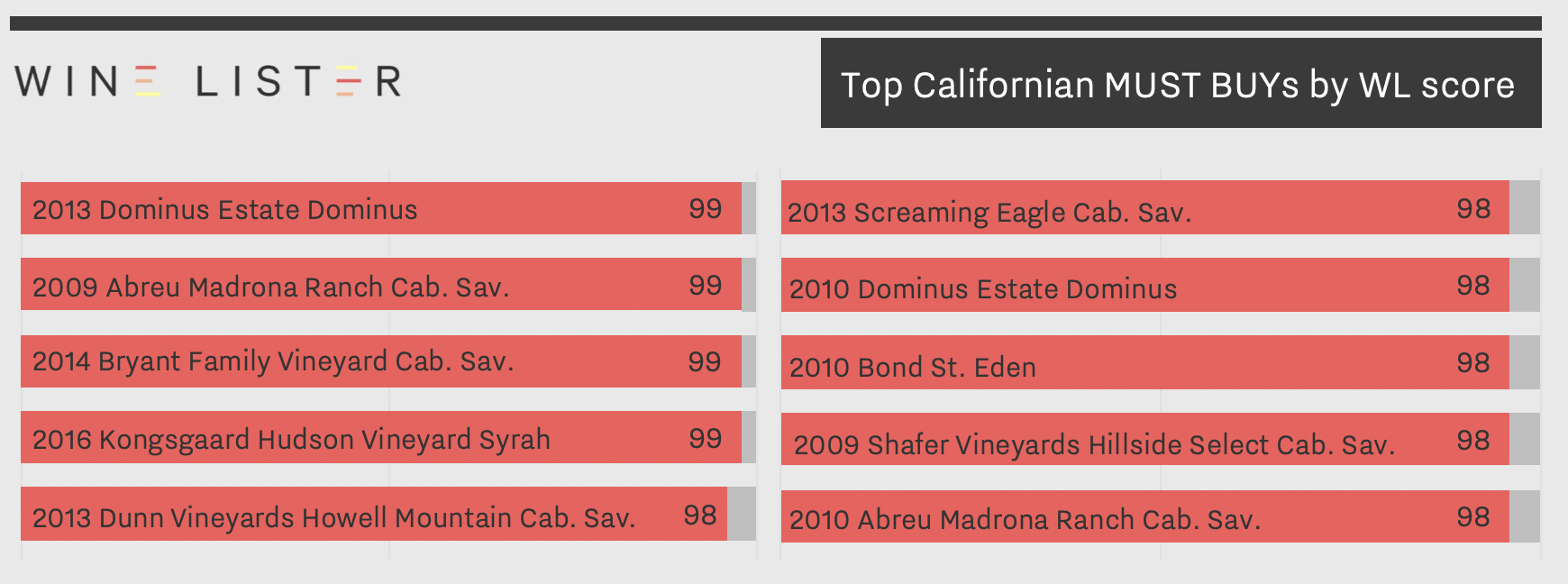
Of these, all are produced in the Napa Valley AVA except Screaming Eagle’s 2013 Cabernet Sauvignon. Dominus Estate achieves two mentions, with vintages 2013 and 2010 both featured. Perhaps unsurprisingly for the New World king of Cabernet Sauvignon, the top 10 Californian MUST BUYs includes just one alternative grape variety – Kongsgaard’s 2016 Hudson Vineyard Syrah.
Explore all 94 Californian MUST BUYs here.
Faced with a new generation of fine wine buyers seeking more of the “weird and wonderful”, let alone recent economic obstacles – Coronavirus keeping drinkers off the streets, US tariffs on European wines – Bordeaux can struggle to find space to thrive.
Bordeaux’s traditional image compared to more fashionable regions such as Burgundy, Piedmont, or Champagne means its prices are lagging behind. The silver lining is that Bordeaux appears excellent value for the high quality available in comparison.
Wine Lister’s dynamic buy recommendation tool currently identifies 219 Bordeaux wines as MUST BUYs – just 19 fewer than the original MUST BUY list from September 2019.
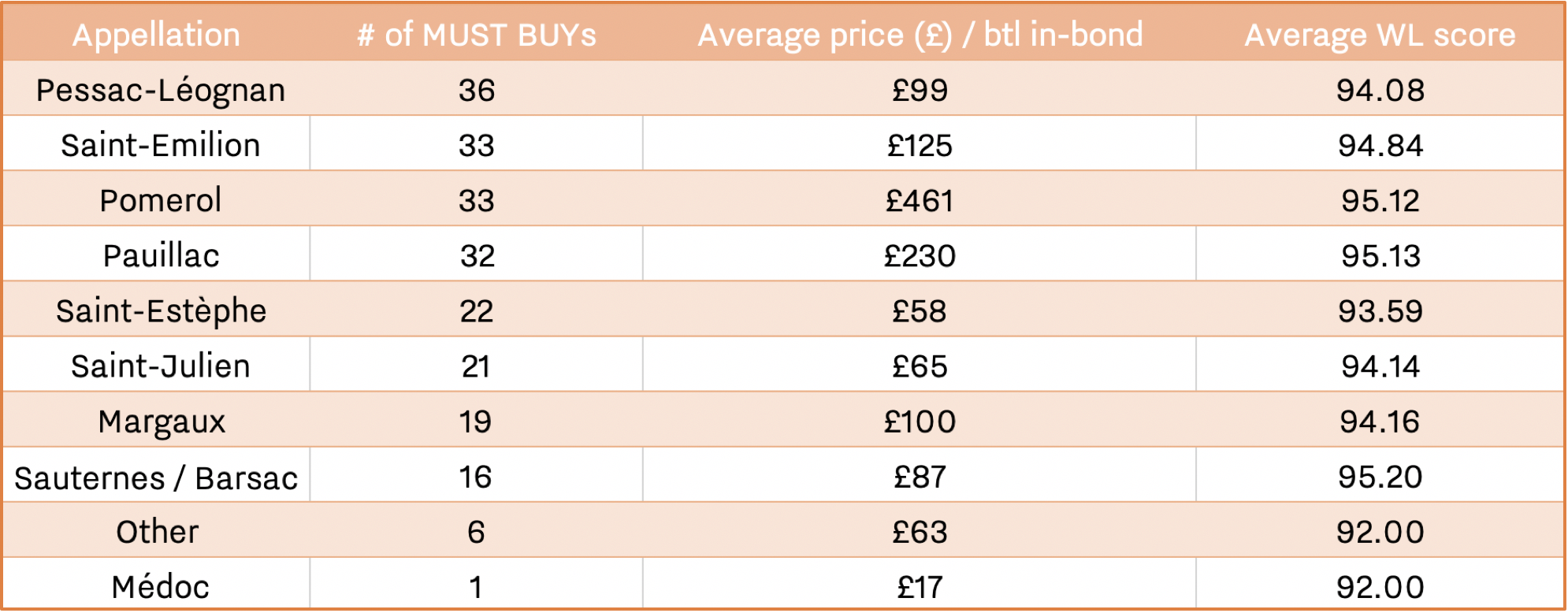
The above table shows each Bordeaux appellation by number of MUST BUYs, as well as average price and WL score of each MUST BUY appellation group. Marking the delayed opportunity presented by slow price evolution post-en primeur, 2016 is the most-featured vintage, achieving 40 entries out of the 219 Bordeaux MUST BUYs (or 18%).
Leading MUST BUY appellation Pessac-Léognan is made up of 28 reds and eight dry whites. Producer Domaine de Chevalier features particularly heavily, earning MUST BUY status for 1981, 2009, 2014, 2015, and 2018 for its red wine, and 2004, 2009, 2010, and 2013 for white. Its second red wine, L’Esprit de Chevalier, appears for the 2016 vintage.
Smith Haut Lafitte and La Mission Haut-Brion share the remaining white places between them, while Haut-Bailly, Haut-Brion, Latour-Martillac, and Malartic-Lagravière achieve multiple entries for reds only. Price-rising superstar Les Carmes Haut Brion features for just one vintage – the 2017.
Right bank appellations Saint-Emilion and Pomerol share second place, with 33 MUST BUYs each. They both earn slightly better average WL scores than Pessac-Léognan, but at prices 26% and 366% higher respectively on average than Pessac counterparts.
The large price difference is hardly surprising in Pomerol, given that its MUST BUY hoard includes five vintages of Petrus, and one of Le Pin. Without these, the average price of Pomerol MUST BUYs is £171, and there are still options at the more affordable end (such as 2016 Vray Croix de Gay).
Powerhouse Pauillac comes next, and includes 14 first growth entries. Mouton takes the lion’s share of these, featuring seven vintages from 1996-2018. Latour earns five places (including one much older vintage – 1964), and Lafite two. Pichon Comtesse also features heavily, earning five MUST BUYs for its grand vin, and one for the Réserve de la Comtesse.
In terms of pure value for money, the one MUST BUY from the Médoc appellation – Potensac 2018 – wins out, followed more generally by Saint-Estèphe’s 22 MUST BUY entries. Perhaps unsurprisingly, its crowned king is Calon Ségur, earning MUST BUY status for five vintages – 2005, 2009, 2014, 2015, and 2016.
Explore all 219 Bordeaux MUST BUYs here.
This week Wine Lister published its first in-depth study of 2020, focusing on the leading wines and producers of Piedmont.
The key takeaways from the report prove Piedmont to be somewhat of an enigmatic region, earning high praise from critics, and experiencing strong long- and short- term price performance, while still lagging behind in terms of consumer popularity.
While this is perhaps a consequence of Nebbiolo’s relative obscurity when compared with international grape varieties, Piedmont’s unique position – a veritable treasure trove of gems to uncover – presents a real opportunity both for vinous discovery and future value.
Wine Lister Pro members can read the full Piedmont report here. All free users can purchase the report for £200 from Wine Lister’s Analysis page.
Below we examine the top Barolos and Barbarescos by WL score.
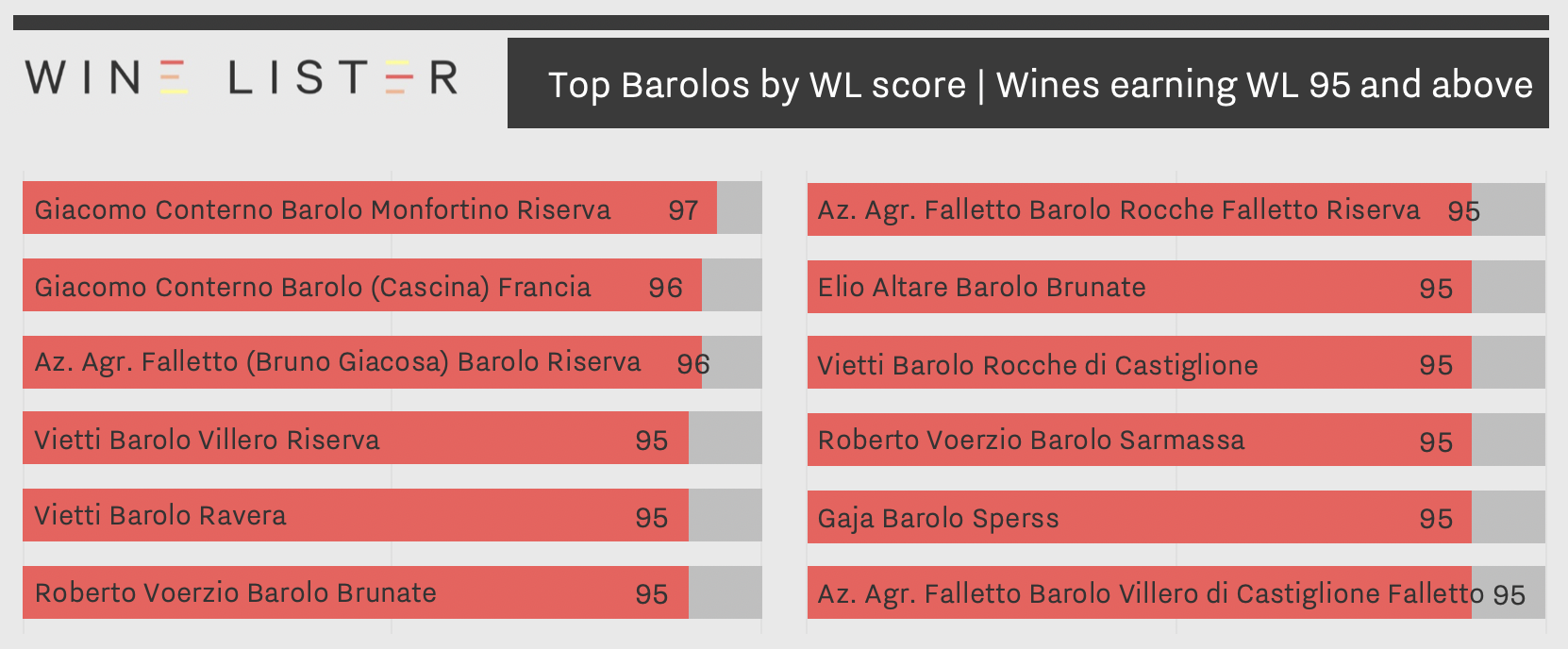
Giacomo Conterno takes both first and second places in the ranking of Barolos by WL score. The icon wine, Barolo Monfortino Riserva is the only Piedmont wine to earn a WL score of 97, while the Barolo Francia shares its score of 96 with the Barolo Riserva from the legendary Bruno Giacosa’s négociant outfit, Azienda Agricola Falletto, as well as the two highest-scoring Barbarescos (see below).
While earning joint-second place for the straight Barolo Riserva, Falletto also features for two site-specific bottlings, the Barolo Rocche Falletto Riserva and Barolo Villero di Castiglione Falleto, making the renowned house the joint-most prolific producer in the top Barolo rankings shown. It shares this position with Vietti, which earns WL 95 for its Villero Riserva, Ravera, and Rocche di Castiglione Barolos.
Elio Altare’s Barolo Brunate is the most reasonably priced of these top 12 Barolos, with an average price of £112 per bottle in-bond (when purchased by the case). Both of Roberto Voerzio’s highest-scoring wines, the Sarmassa and Brunate, follow with average prices of £152 and £165 respectively.

Eight Barbarescos achieve a WL score of 95 or above. The appearance of multiple wines per producer is accentuated here, with Roagna and Gaja earning three places apiece, followed by two Barbarescos from Falletto (totalling seven wines in Falletto’s hoard of WL scores of 95 and above).
Both sets of rankings provide useful leads in terms of producers to look out for, particularly heading into further releases of Barolo’s latest vintage, 2016, in the spring. For more specific recommendations of further Piedmontese wines and back vintages, see the region’s full list of MUST BUYs, and / or Piedmont’s Hidden Gems.
 Results from Wine Lister’s 2020 trade survey show Les Carmes Haut-Brion achieves first place for sharpest rise in demand of Bordeaux wines.
Results from Wine Lister’s 2020 trade survey show Les Carmes Haut-Brion achieves first place for sharpest rise in demand of Bordeaux wines. Four releases from Tuesday 23rd June land within the top 10 Bordeaux wines to be voted by key members of the trade as most likely to see future prestige – Les Carmes Haut-Brion, Vieux Château Certan, Canon, and Rauzan-Ségla.
Four releases from Tuesday 23rd June land within the top 10 Bordeaux wines to be voted by key members of the trade as most likely to see future prestige – Les Carmes Haut-Brion, Vieux Château Certan, Canon, and Rauzan-Ségla. A different time – a throwback to 2018 and a celebration at Château Berliquet, of its acquisition by the Chanel group.
A different time – a throwback to 2018 and a celebration at Château Berliquet, of its acquisition by the Chanel group. Picnic with Director Pierre Graffeuille – Wine Lister’s CEO, Ella Lister, tasted the Las Cases 2019s in Bordeaux two weeks ago, and describes the Grand Vin as “Luminous, transparent, and lyrical”.
Picnic with Director Pierre Graffeuille – Wine Lister’s CEO, Ella Lister, tasted the Las Cases 2019s in Bordeaux two weeks ago, and describes the Grand Vin as “Luminous, transparent, and lyrical”.

 Virtual tasting – Wine Lister’s Founder & CEO, Ella Lister, tastes the Baron Philippe de Rothschild 2019s with Philippe Sereys de Rothschild and Managing Director, Philippe Dhalluin.
Virtual tasting – Wine Lister’s Founder & CEO, Ella Lister, tastes the Baron Philippe de Rothschild 2019s with Philippe Sereys de Rothschild and Managing Director, Philippe Dhalluin. 23rd September 2019 – some of the first Merlot grapes to be harvested at Pichon Baron.
23rd September 2019 – some of the first Merlot grapes to be harvested at Pichon Baron.









